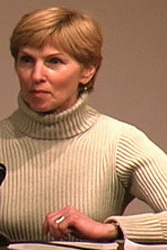|
Tom Richards: We both talked about Calista. I should make a comment about Calista. I don’t mean anything derogatory about the Calista Corporation or the region or the folks there. I had many, many years and some of the most wonderful experiences working with Yup’ik people. It’s been really unfortunate that that whole region has been so dependant upon the commercial salmon fishing industry, which has been in years and years of decline and now is on the verge of total collapse. But there are bright spots. I noticed in the last day or two that some of the Calista and the Kuskokwim Corporation land holdings in the upper Kuskokwim have a lot of gold and the price of gold has been steadily rising. It’s looking like it may be feasible to bring the mining properties they own into production. The forecast is now that they may be able to produce a million ounces of gold a year and provide 500 to 600 jobs for their shareholders. That means the money could start moving the other way. So I don’t mean any disrespect at all to the folks at Calista. Thank you, John.
Our next speaker, Janie Leask, is Haida-Tsimshian, originally from Metlakatla. When I met her she was the secretary at AFN. That was more than a couple of years ago and I think, since then, she has held virtually every job within AFN, and ultimately became president. We’re very fortunate to enjoy the benefit of her leadership and her insight on public policy issues. She has recently been appointed to the Alaska Permanent Fund Board, and she’s active in public affairs including the upcoming gubernatorial race. Please welcome Janie Leask.
 |
| Janie Leask |
 |
Janie Leask: By way of introduction, I’m Haida-Tsimshian originally from Metlakatla. On my father’s side my grandmother was Haida from the village of Klinkwan and my grandfather was Tsimshian from Metlakatla. His ancestors go back to old Metlakatla British Columbia where a Scottish gentleman by the name of Leask from the Orkney Islands jumped ship and married a Native woman. My mother’s family was Irish-German; they were settlers originally from Saint Paul, Oregon; I don’t know how much more Irish and German you can get on that side.
I started work at AFN in 1974 when I came back to the state. My family moved here in 1959, and I stayed here through 1966 when I graduated from school and went off and did a lot of different things. I stopped by Metlakatla, worked in a cannery, and came to Anchorage. My father knew Roger Lang, who was a fellow Tsimshian, and my father, being the good father, wanted to make sure that his daughter had a job. He took me down to AFN and introduced me to Roger Lang, and I started working in the Manpower Department as a technical assistant, which was basically a clerk typist. I had never gone to college; I didn’t have the patience. I wanted to get out and do. I still do.
I started working at AFN in really exciting times. Willie Hensley had just finished running for office. Roger Lang and I had the privilege of working with Sam Kito, Byron Mallott, Morris Thompson, former State Senator Frank Ferguson. One of my mentors was John Shively at a very early age said, “Just go Janie.” He would laugh and say, “When you become vice president of AFN,” and I said, “John, that would never happen.” He kept on pushing.
AFN was really going through a lot of different changes at the time, very exciting changes with the board of directors. When I started there was a board of directors for the twelve regional corporations and a human resource committee, and we expanded that to include the human resources part of the board. This was not without its little contentiousness from the board because of who was going to be paying the dues and basically supporting the organization. Subsistence was also very much of an issue.
I worked my way up through the ranks, again with a lot of nudging and help from my friends, and I also had a passion for what was going on. In 1982, when Senator Ferguson decided to step down, it was, “Okay Janie, it’s either step up or out.” I looked at some options, and I was actually thinking about working for Governor Sheffield, running his Anchorage office, and I was approached by a couple of friends who basically said, “I don’t think so.” I really thought about it and decided that, yeah, there were some things I really wanted to do. I was very comfortable working behind the scenes of AFN, running the office while Byron Mallott was getting Sealaska started and Senator Ferguson was in the state legislature. Morris was running for U.S. Senate at the time, so I was running the office and it was wonderful because I could run the office and be in control but not have to be the president.
In 1982, when I decided to become president of AFN, a repeal of the state subsistence law was on the ballot. That was a big campaign. Then, that same year at the convention, we asked the Alaska Native Foundation to look at what some of the unfinished business of ANCSA.
|
 |
|




